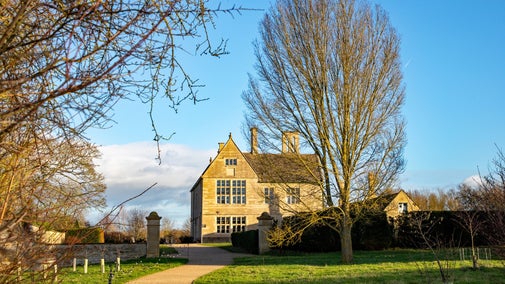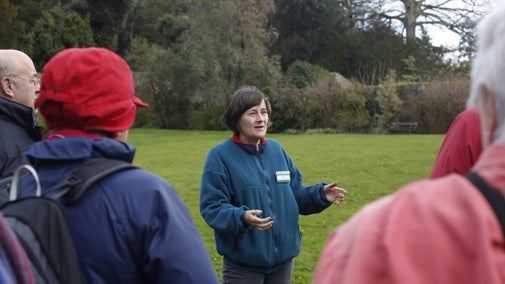
Donate
Everyone needs nature, now more than ever. Donate today and you could help people and nature to thrive at the places we care for.

Lyveden was created by Sir Thomas Tresham to symbolise his Catholic faith. Since 1922 the National Trust has been caring for this enigmatic place, discovering lost areas of the garden and telling its stories. Find out more about our work at Lyveden, including the archaeological investigations taking place to uncover its secrets.
Lyveden is considered one of the greatest architectural survivals of the Elizabethan period. Studies have been done across the property, from surveys of historical graffiti on the lodge to excavation studies in the lower gardens.
Over recent decades a significant amount of archaeological study has been undertaken at Lyveden. From the discovery and uncovering of the moats, spiral mounts and the planting of the orchard, the property has grown in size and historical significance.
The knowledge of what Tresham planned for the lower reaches of his gardens was limited to the cryptic clues contained in the Tresham papers, such as descriptions of his “ascents” and “shaded arbours”.
Aerial photography analysis undertaken in the 1970s suggested the existence of a series of terraces climbing up the hill from the manor to the orchard.
Over the autumn and winter of 2017, the team commissioned a suite of archaeological investigations to get to the bottom of this mystery and discover how work on the lower gardens at Lyveden had progressed before Tresham’s death in 1605.
In order to discover whether any terraces were planned at Lyveden and how much of Tresham’s landscape survives, local archaeologists Iain Soden Heritage opened three evaluation trenches in the grounds around Lyveden Manor.
The team found archaeological evidence that the viewing platform at the top of the terraces was in existence at the time the work on the garden stopped. On the north side of the cut, was a mid-grey clay deposit which contained many fragments of seventeenth century pottery. This layer also contained a substantial quantity of medieval Lyveden pottery fragments.

The lower garden was cultivated for agriculture from the 1940s onwards and so, as with other areas of the site, such as the parterre and labyrinth, it is possible that heavy ploughing may have disturbed and destroyed any archaeological evidence remaining in the earth.
To get a clear picture of the landscape contours at Lyveden, the team also commissioned a LiDAR survey, which using light waves can pick up minute changes in ground levels that are not visible to the naked eye or standard photograph. It is therefore frequently used to search for hidden or lost earthworks.
The LiDAR data showed that the area surrounding the Manor and lodge was part of an extensive medieval field system, characterised by ridge and furrow earthworks.
The trenching in the lower garden corroborated this interpretation, digging up flint and rounded pebble inclusions indicative of medieval agriculture, but nothing associated with post-medieval work. The LiDAR analysis confirmed the existence of a top viewing platform, but no earthworks further down the slope.
Both the LiDAR and trenching analysis confirm that work had begun on a top terrace in the lower gardens, with evidence also showing plans for an extended viewing platform. There is no evidence of work beginning on any other terraces on the slope stretching down to the manor.
Like the lodge, the unexcavated fourth side of the moat, and the western spiral mount in the moated orchard, it seems that the terraces were also incomplete and abandoned after both Thomas and Francis Tresham died.

Sir Thomas Tresham’s orchard was described as ‘one of the fairest orchards that is in England’ before its premature abandonment in 1605.
Since 2000, the team have set about restoring the orchard to its former glory by replanting many of the old varieties of fruit specified by Tresham himself.
The replanting of the orchard took inspiration from contemporary records and Tresham's letters to his workmen. The team could see from those letters that Tresham planned to include apples, pears and damsons as well as a 'walk' of cherries and walnuts.
The orchard recreation took 2 years to complete and now features over 300 trees of 19 different varieties planted in formal avenues. Some of the species, such as the Winter Queening apple, were listed in Tresham's letters. Others were recorded locally in the early sixteenth and seventeenth centuries.
With your ongoing support, we're able to continue our vital conservation work. Thank you for helping to protect these special places.

Everyone needs nature, now more than ever. Donate today and you could help people and nature to thrive at the places we care for.
With a manor house to see, plan your visit here, with historical talks, information on the garden design and our temporary exhibition space there's plenty to see and do.

Discover how religious persecution, treason and debt stopped Tresham’s vision from being fulfilled and why Lyveden stands as a reminder of his act of quiet and creative rebellion.

Find out more about volunteering at Lyveden. By joining the team, you'll help bring to life the stories of this intriguing Elizabethan lodge.

Read about our strategy, which focuses on restoring nature, ending unequal access and inspiring more people.

We believe that nature, beauty and history are for everyone. That’s why we’re supporting wildlife, protecting historic sites and more. Find out about our work.
